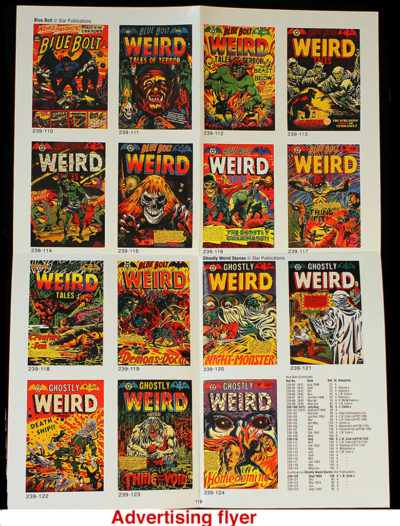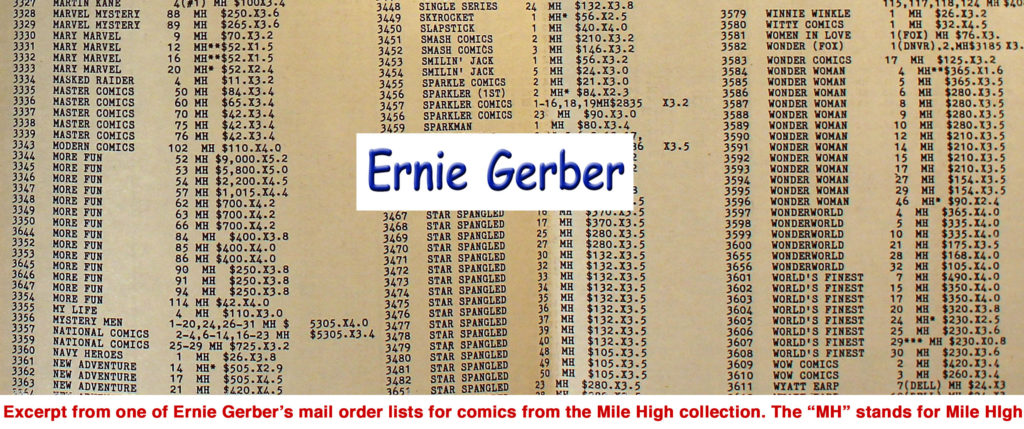Ernie Gerber was a big mover and shaker in the comic book collecting hobby. He invented the widely used Mylar Snug for preserving comic books that everybody in the hobby uses. The Mylar supply company he founded, E. Gerber Products is still in business as a subsidiary of Steve Geppi’s Diamond Distributors. Gerber also ran auctions of old comic book auctions in the 1980s and 1990s. The dealer John Verzyl who still today conducts his own comic auctions told me once in the 1980s that he wished he had Ernie’s list of customers. Ernie Gerber’s main claim to fame though is the two volume reference book The Photo-Journal Guide To Comic Books published in 1989. He spent five years traveling the country photographing comic book collections and used thousands of dollars of his own money to make that book a reality. Comic fandom owes him a debt that can’t be repaid. Nobody else had the devotion to comic books and the courage and tenacity to take on a project like that.

I first became aware of Ernie Gerber about 1977 when his ads for his new Mylar Snugs began appearing in the Overstreet Price Guide. I had put my own comic collection in storage using regular plastic bags in 1977 when I joined the Air Force and left Savannah, Georgia for a career in the Air Force. I wanted to use the new Mylar Snugs so sometime in in the late 1970s I ordered about 3,000 Mylar Snugs and had them mailed to my home in Savannah. I took leave and flew from California to Savannah and switched all my comics from the plastic bags into the Snugs where the’ve been ever since. I was tickled to see one of Ernie’s Mylar ads in the 12th edition of the Ovestreet Price Guide for 1982 that he had listed “Lewis Forro, Savannah” as one of his Mylar Snug distributors..
I was heavy into buying old comic books from John Verzyl and other dealers in the 1980s while stationed in California and somehow I got on Ernie’s mailing list for his comic auctions. I never bid on any books but I enjoyed looking over the great books Ernie had listed. I especially liked reading his comments on the famous Mile High / Edgar Church pedigree collection since I was involved myself in buying some of those books from John Verzyl. Click here for photos of some of Ernie’s 1988 auction catalog pages which feature Mile High comics.
About 1990 Ernie started sending out advertising samples to his mailing list customers about this colossal project he was working on, a reference book with 21,000 color photos of comic books, The Photo-Journal Guide To Comic Books. I liked the idea and signed up in advance for the two volume trade edition set and also the Deluxe set. Click here for photos of promotional materials Ernie used to seduce his customers into buying his new book.
I had talked to Ernie once briefly on the phone but I never met him person until I saw him at the San Diego Con in 1991. He was setup as a dealer selling his new book. He told me the color separations for each page of the book costs $700 as he decided to use the best process for doing separations. He said he had to mortgage his home to help raise the money and he joked that he needed all the sales he could get to pay off his debts. He told me he was planning the second two volumes which would be all Marvel comics and he was thinking about additional volumes later devoted to DC comics. The next two Marvel volumes did happen but nothing after that as Ernie died in the late 1990s. The last correspondence I have from him is from 1997.
When the Marvel volumes were published I bought the two regular trade editions and the single volume Deluxe edition which contained 16 extra pages of pre-Marvel books like Tales Of Suspense, Tales To Astonish that weren’t in the trade editions. I also bought a second copy of the Deluxe edition which is still unopened in the mailing package, salted away for a rainy day. As he did for the first two volumes, Ernie offered Gerber Press Proofs from the Marvel volumes. I bought some of the superhero title proofs and I was especially glad to buy some of the pre-Marvel proofs. Click here for photos of some of these proofs that I got from Ernie. Ernie claimed these would be good investments as they were made in small quantities. Today, it’s hard to figure out what they are worth as you don’t see them hardly anywhere. Even on ebay they they rarely turn up.

For many years in the late 1980s and early 1990s Ernie was out of the Mylar business. I don’t know the details but Ernie quit making Mylar Snugs and signed a non-competition agreement with his his former competitor Bill Cole Enterprises. While out of the business I believe he was still collecting royalties from Cole as Ernie still had the patents for heat sealing Mylar. In the mid 1990s Ernie’s non-competition agreement expired and he went back into the Mylar business with E. Gerber Products. I called him on the phone and thanked him for undercutting Bill Cole’s high prices. Ernie agreed that his customers shouldn’t have to pay high prices for Mylar and to this day E. Gerber Products’ Mylar Snugs are still cheaper than Bill Cole. That was the last time I spoke to Ernie.
Ernie intended his The Photo-Journal Guide To Comic Books to be the definitive reference for how to price and collect comics. From the vantage point of today in 2012, in some ways it is and some ways it isn’t. Ernie’s Relative Value Index (RVI) for pricing a comic book doesn’t appear to be used by anybody. There are plenty of internet auction sites and price guides to use instead that are more in tune with the evolving market. His Scarcity Index may still have some value and I’ve seen some dealers reference it but I think the Certified Guaranty Company (CGC) which keeps a database of its graded comics has probably replaced it. Ernie also assigned each comic an identification number which he copied from the coin hobby. That never caught on with anybody.
However Ernie was right about his idea that a market of rare, hard to find comic books will grow bigger if people can easily see what books are available. When you see a nice photo of a book you’ve never seen before it makes you want it more. I’m sure the size of the comic collecting hobby today was stimulated by Ernie’s book. Strangely though, there is no serious collectible price value to Ernie’s long out of print books. I checked ebay completed auctions and you can buy the books now in 2012 for less than Ernie was selling them for over 20 years ago. Pretty weird, huh?
Aside from the historical or collectible importance of Ernie’s books, there is one thing for sure. The books are just plain fun to look through. Ernie shot his photos with a 35mm camera and the photos of the comic book covers in the books are sharp and clear. Even in the smaller photos if you use a magnifying glass you can easily read the print in the dialog balloons on the covers. I’ve spent many a pleasant evening doing just that. Unless you are rich and have 21,000 Golden and Silver Age comics in your personal collection, where else can you go to see all those covers in color? You can search and fumble around on the Grand Comic Book Database on the Internet waiting for pages of comic covers to download. But that doesn’t give nearly the pleasure and convenience of sitting in your easy chair and thumbing through all those wonderful color photos right there in front of you. I’m sure Ernie’s book will never be forgotten.

